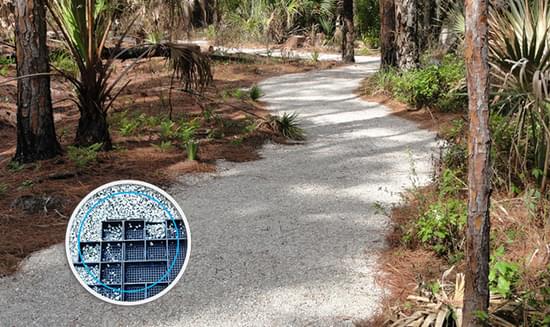




Permeable Pavers provide stable, low-impact pathway through Rookery Bay Research Reserve.

The nature observatory trail at Rookery Bay is a barrier-free pathway through one of Florida’s most scenic and environmentally sensitive areas.
Building and maintaining a stable walkway through a popular nature reserve in an area with exceptionally soft soils was challenging. Accommodating barrier-free access while minimizing the environmental disturbance compounded the challenge.
The Rookery Bay National Estuarine Research Reserve stretches across 110,000 acres of pristine mangrove forest, uplands, and protected waters. Rookery Bay is one of 29 protected reserves and is a popular destination for visitors who want to fish, camp, or observe endangered or threatened wildlife in its natural habitat.
Project leaders at Rookery Bay required an economical and low-maintenance solution for building a walking trail that would allow visitors to safely explore the environmentally sensitive areas within the reserve. The trail also needed to be ADA compliant and able to support occasional traffic from maintenance vehicles. To meet these project requirements, the engineer chose the GEOPAVE® Gravel Porous Paver System.
A Better Solution for Building Trails through Wetlands & Coastal Areas
The Rookery Bay Research Reserve's location along the Florida Gulf Coast made it necessary to design a trail with a stable, permeable surface that would be unaffected by the harsh conditions of a coastal environment. The GEOPAVE® Gravel Porous Paver System uses durable synthetic pavers manufactured from recycled high-density polyethylene (HDPE), which are resistant to degradation and corrosion. The inert nature of the pavers makes them an ideal solution for trail projects located in coastal environments and wetlands where saltwater, sea salt aerosol, corrosive soil, high groundwater table conditions, and cyclic wetting and drying of the trail surface can substantially reduce the longevity and performance of traditional construction materials.
Through the confinement of aggregate, the GEOPAVE system creates a stable, low-maintenance trail surface. The highly permeable pavers reduce stormwater runoff and surface water ponding, allowing for natural percolation through the permeable infill and underlying granular base. A stable trail surface minimizes rutting and washboarding, resists surface erosion, and eliminates standing water that can create muddy, impassable surfaces. The GEOPAVE system creates a trail surface that can withstand variable weather events, including heavy precipitation and extreme temperatures.
Trails built through nature preserves or protected areas also frequently require a low environmental impact solution to prevent damage to trees, protected habitats, and environmentally sensitive areas. For example, when construction equipment and vehicles intrude on a tree's critical root zone without proper protections in place, they can negatively impact the soil environment and endanger the structural integrity of the tree. The GEOPAVE system's load-spreading ability minimizes this by reducing soil compaction and damage to near-surface roots. Additionally, the open-graded aggregate surface allows moisture and precipitation to reach the tree’s roots.
Easy Installation Allows for Trail Customization
The design of the GEOPAVE system allows for easy installation, requiring less site preparation, excavation, and required structural base than other porous pavement systems. The GEOPAVE units come in 20-inch by 40-inch panels, which can easily be cut with ordinary hand tools for installation around obstructions, contours, and irrigation systems. Because of this, the GEOPAVE system was able to accommodate the winding trail through the Rookery Bay Reserve.
When designing the nature observatory trail, the engineer chose to install the GEOPAVE units in an offset pattern, changing the orientation of the units with each row. Either an offset or bricklayer pattern is recommended for pedestrian traffic; however, the pavers can also be arranged in a herringbone pattern if heavier vehicle traffic is anticipated. The crew installed over 15,000 square feet of GEOPAVE pavers directly over the sand subgrade. Depending on the type of loading and the percolation rate of the subgrade, a geotextile separator fabric and a base layer of aggregate can be added underneath the panels. This complete system created a flat, stable surface to support pedestrian traffic, along with occasional traffic from maintenance vehicles.
For more information on designing and building permeable recreational trails, visit www.prestogeo.com. Presto Geosystems offers free design tools and project support to help you with your next trails project.